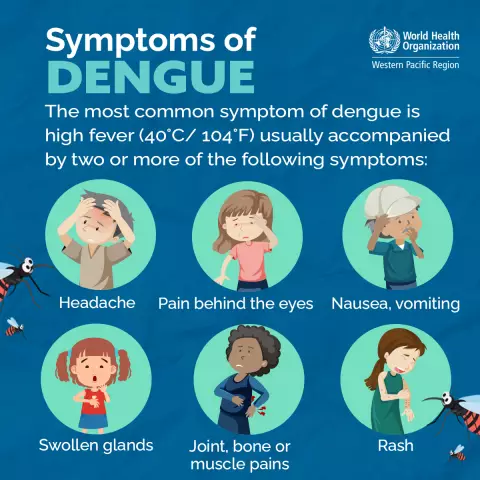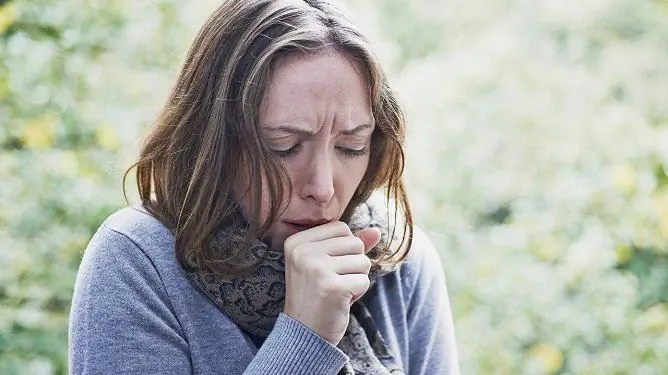- Author Rachel Wainwright [email protected].
- Public 2023-12-15 07:39.
- Last modified 2025-11-02 20:14.
Signs of pneumonia without cough and fever in adults
The content of the article:
- Diagnosis of pneumonia
-
Signs of pneumonia
- By severity
- By stages of the disease
- Asymptomatic course of the disease
- Treatment of pneumonia in adults
- Video
Pneumonia is an acute inflammatory disease that is accompanied by symptoms of lower respiratory tract infection and radiological signs of fresh focal infiltrative changes in the lungs.

In some cases, pneumonia is not accompanied by cough and fever
Pneumonia is most often caused by gram-positive and gram-negative pathogenic bacteria that enter by inhaling small droplets or aspiration of secretions from the mucous membranes of the upper respiratory tract.
In addition, in the etiology and pathogenesis of the disease, the presence of chronic foci of inflammation plays a role, from which pathogens can be spread through the lymph or with the bloodstream, as well as a violation or decrease in immunity in humans.
The development of pathology can be associated with internal and external factors, such as hypothermia, air pollution or smoke, active and passive smoking, the presence of concomitant diseases.
Diagnosis of pneumonia
To establish a diagnosis, it is necessary to take into account all the patient's complaints, carefully collect the medical history, conduct the necessary laboratory and instrumental studies. Depending on the severity of the clinical manifestations of the disease, the diagnostic list may vary.
Basic diagnostic methods that aid in confirming pneumonia include:
- clinical blood test;
- biochemical blood test (liver enzymes, electrolytes, creatinine);
- microscopic and cultural examination of sputum to determine the type of pathogen and its sensitivity to antibacterial drugs;
- chest x-ray in two projections;
- ECG (electrocardiography).

Radiography is one of the main methods for diagnosing pathology
According to the indications, additional studies can be carried out:
- hemostasiogram (indicators of the blood coagulation system);
- determination of arterial blood gases;
- PCR (polymerase chain reaction) of blood or sputum for the presence of atypical microflora: chlamydia, mycoplasma, aspergillus, legionella, cytomegalovirus, etc.;
- blood culture study (carried out by taking two samples of venous blood from different veins);
- spirometry;
- pleural puncture with cytological, biochemical and microbiological examination of pleural effusion;
- fibrobronchoscopy with a biopsy of the mucous membrane (if a neoplasm is suspected);
- computed tomography of the thoracic segment (exclusion of tuberculosis, neoplasms);
- lung biopsy.
Signs of pneumonia
By severity
There is a classification of pneumonia depending on the severity of the patient's condition:
- easy;
- medium;
- hard.
With a mild severity, there is an increase in body temperature up to 38 ° C, slight shortness of breath during exertion, weak intoxication of the body. The patient's consciousness is clear, blood pressure is normal, and there are no hemodynamic disturbances. The heart rate may increase up to 90 beats per minute. On the roentgenogram, a small lesion is determined, pulmonary infiltration within no more than one segment. In the clinical analysis of blood, leukocytosis is determined with a shift of the formula to the left, an increase in ESR (erythrocyte sedimentation rate). C-reactive protein appears in the blood.
Moderately severe symptoms of intoxication are characteristic of moderate pneumonia; body temperature most often rises to febrile numbers (above 38.0 ° C). The patient has pallor of the skin, general weakness, sweating, an increase in heart rate up to 100 beats per minute, a decrease in blood pressure, shortness of breath occurs at rest. Consciousness is clear. On the roentgenogram, pulmonary infiltration occupies 1-2 segments of the lung.
With a severe course of the disease, the general condition of the patient is severe. Against the background of a high body temperature (above 38 ° C), pronounced signs of intoxication of the body are determined: dim consciousness, weakness, delirium, tachycardia more than 100 beats per minute, a decrease in blood pressure below 90 mm Hg. Art.

Shortness of breath and general weakness are characteristic symptoms of pneumonia
The patient has dyspnea at rest (30-40 respiratory movements per minute), pallor of the skin and cyanosis of visible mucous membranes, the tip of the nose, fingers, and earlobe.
A patient with severe pneumonia needs vasopressors due to hemodynamic disturbances. On X-ray images, multi-lobe, bilateral pneumonic infiltration is determined. In a clinical analysis of blood, leukocytosis or leukopenia is determined.
Severe pneumonia is characterized by rapid progression of the inflammatory process: the infiltration zone in 48 hours can increase by 50% with abscess formation and pleural effusion. Consciousness is impaired, respiratory failure is increasing. Failure of other organs and systems, sepsis may develop.
By stages of the disease
In the development of pneumonia, the stages of tide, compaction and resolution are distinguished.
The tide stage is characterized by an acute onset. The first sign may be chills (due to a rise in body temperature). The patient notes a headache, dry cough, chest pain, aggravated by inspiration. Hyperemia of the cheek and lagging of the chest from the healthy one on the side of the lesion can be determined. When shortness of breath appears, the wings of the nose begin to swell.
The tide stage lasts from 12 hours to 3 days. During this time, a sharp blood filling of the vessels occurs in the lungs, and fibrous exudation is detected in the alveoli.
In the stage of compaction, there are: red hepatization - lasts from 1 to 3 days; gray hepatization - lasts from 2 to 6 days.
Due to the fact that there is a compaction of the lung tissue and exudation of a large number of red blood cells into the alveolar exudate, rusty sputum may be expelled. Then there is a massive release of leukocytes into the alveoli, and the sputum becomes purulent. Increased chest pain when breathing and coughing. The skin and visible mucous membranes are pale, with a cyanotic tinge. Consciousness can be clouded.
In the resolution stage, the body temperature gradually decreases, the cough becomes productive and a large amount of sputum leaves. The general condition of the patient eventually returns to normal, and the normal structure of the lung tissue is restored.
Asymptomatic course of the disease
In rare cases, pneumonia can begin without fever, be asymptomatic, or develop against the background of signs of acute respiratory viral infection (acute respiratory viral infection) or bronchitis: a slight increase in body temperature, cough, general malaise.
Such a latent course - signs of pneumonia without fever, without coughing in adults and children - is the most dangerous form of pathology, since there is a high probability of complications.
Treatment of pneumonia in adults
Pneumonia is treated directly by a doctor, and self-medication can lead to numerous complications.

With bacterial pneumonia, antibiotics are prescribed, in particular Amoxiclav
Therapy of the disease is aimed at eradication of the pathogen, relief of symptoms, resolution of infiltrative changes in the lung tissue and prevention of complications of the disease.
To combat the infectious agent, antibacterial drugs of a wide spectrum of action are prescribed: Amoxiclav, Azithromycin, Cefotaxime, Ceftriaxone, Spiramycin, Roxithromycin. Alternative medicines can be: Doxycycline, Levofloxacin.
The dosage of the antibiotic and the duration of the course are selected by the doctor individually for each patient, depending on the severity of the pneumonia. The standard course is 10 days.

Before starting therapy, it is important to pass the tests necessary to identify the causative agent of the disease.
The sensitivity of the selected antibiotic can be checked by the result of bacteriological examination of sputum and, if the pathogen is resistant, the drug can be replaced. Therefore, it is important to take the necessary tests before starting antibiotic therapy so that the results can be reliable.
Depending on the severity of the condition, concomitant diseases and the presence of complications, the patient is treated in a hospital or at home. In the latter case, a prescription for antibiotics is issued.
An important role is played by symptomatic therapy, which includes expectorant and antipyretic drugs. Sometimes doctors are allowed to use folk remedies, but only together with the main treatment.
If pain in the chest occurs, even without a high body temperature and the appearance of a cough, it is necessary to consult a specialist to find out the reason, since pneumonia can manifest itself.
Video
We offer for viewing a video on the topic of the article.

Alina Ervasova Obstetrician-gynecologist, consultant About the author
Education: First Moscow State Medical University. THEM. Sechenov.
Work experience: 4 years of work in private practice.
Found a mistake in the text? Select it and press Ctrl + Enter.






